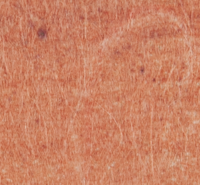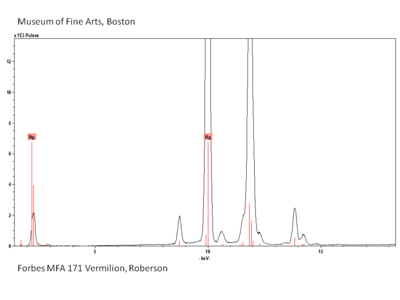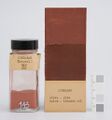Difference between revisions of "Category:Vermilion: Ukiyo-e colorant"
| (19 intermediate revisions by the same user not shown) | |||
| Line 1: | Line 1: | ||
| − | [[File: | + | [[File:SC145786.jpg|right|300px|link=Hokkei, Goat Standing by a Plum Tree, 21.9277|Goat Standing by a Plum Tree by Totoya Hokkei]] |
| − | <font size="3">'''[[Vermilion]]'''</font> 朱(''shu''): A bright red pigment composed of synthetically prepared red mercuric sulfide. Vermilion is chemically identical to the mineral [[Cinnabar|cinnabar]] (辰砂 ''shinsha''). | + | <font size="3">'''[[Vermilion]]'''</font> 朱 (''shu''): A bright red pigment composed of synthetically prepared red mercuric sulfide. Vermilion is chemically identical to the mineral [[Cinnabar|cinnabar]] (辰砂 ''shinsha''). |
| − | Vermilion | + | Vermilion appears to have been rarely used as a colorant in ''ukiyo-e'' prints. In the mid-1800s it seems to have been mixed with [[:Category:Madder: Ukiyo-e colorant|madder]] to create a darker red color mostly seen used on cartouches. Although not part of the printing matrix, vermilion is also found in the collector's seals on ''surimono'' prints (摺物). Vermilion is the commonly used red ink for seals. |
| − | '''For | + | '''For additional information see:''' [[Vermilion]] |
| + | <br> | ||
<br> | <br> | ||
== Examples of Vermilion in Ukiyo-e Prints == | == Examples of Vermilion in Ukiyo-e Prints == | ||
| − | {|class="wikitable" style="display: inline-table;font-size:90%;text-align:center;width:15%" | + | {| class="wikitable" style="display: inline-table;font-size:90%;text-align:center;width:15%" |
| − | |[[File: | + | |[[File:21.9277-pt2-detail.png|200px|link=Hokkei, Goat Standing by a Plum Tree, 21.9277]] |
|- | |- | ||
| | | | ||
| − | [[File:Indigo FORS.JPG|200px]]<br>[[ | + | [[File:Indigo FORS.JPG|200px]]<br>[[Hokkei, Goat Standing by a Plum Tree, 21.9277|Pt 2: Printed<br>Totoya Hokkei, 21.9277]] |
|} | |} | ||
| + | |||
{| class="wikitable" style="display: inline-table;font-size:90%;text-align:center;width:15%" | {| class="wikitable" style="display: inline-table;font-size:90%;text-align:center;width:15%" | ||
| − | |[[File:dyed indigo.jpg|200px]] | + | |[[File:dyed indigo.jpg|200px|link=]] |
|- | |- | ||
| | | | ||
| − | [[File:Indigo FORS.JPG|200px]]<br>[[Harunobu, Beautiful Women of the Yoshiwara, Applying makeup (MFA 2006.1537.5)| | + | [[File:Indigo FORS.JPG|200px]]<br>[[Harunobu, Beautiful Women of the Yoshiwara, Applying makeup (MFA 2006.1537.5)|Pt 4: Brass flakes<br>Torii Kiyomasu II, 58.343]] |
|} | |} | ||
| + | |||
{| class="wikitable" style="display: inline-table;font-size:90%;text-align:center;width:15%" | {| class="wikitable" style="display: inline-table;font-size:90%;text-align:center;width:15%" | ||
| − | |[[File:dyed indigo.jpg|200px]] | + | |[[File:dyed indigo.jpg|200px|link=]] |
|- | |- | ||
| | | | ||
| − | [[File:Indigo FORS.JPG|200px]]<br>[[Harunobu, Beautiful Women of the Yoshiwara, Applying makeup (MFA 2006.1537.5)| | + | [[File:Indigo FORS.JPG|200px]]<br>[[Harunobu, Beautiful Women of the Yoshiwara, Applying makeup (MFA 2006.1537.5)|Pt 4: Brass flakes<br>Torii Kiyomasu II, 58.343]] |
|} | |} | ||
| + | |||
{| class="wikitable" style="display: inline-table;font-size:90%;text-align:center;width:15%" | {| class="wikitable" style="display: inline-table;font-size:90%;text-align:center;width:15%" | ||
| − | |[[File:dyed indigo.jpg|200px]] | + | |[[File:dyed indigo.jpg|200px|link=]] |
|- | |- | ||
| | | | ||
| − | [[File:Indigo FORS.JPG|200px]]<br>[[Harunobu, Beautiful Women of the Yoshiwara, Applying makeup (MFA 2006.1537.5)| | + | [[File:Indigo FORS.JPG|200px]]<br>[[Harunobu, Beautiful Women of the Yoshiwara, Applying makeup (MFA 2006.1537.5)|Pt 4: Brass flakes<br>Torii Kiyomasu II, 58.343]] |
|} | |} | ||
| + | |||
{| class="wikitable" style="display: inline-table;font-size:90%;text-align:center;width:15%" | {| class="wikitable" style="display: inline-table;font-size:90%;text-align:center;width:15%" | ||
| − | |[[File:dyed indigo.jpg|200px]] | + | |[[File:dyed indigo.jpg|200px|link=]] |
|- | |- | ||
| | | | ||
| − | [[File:Indigo FORS.JPG|200px]]<br>[[Harunobu, Beautiful Women of the Yoshiwara, Applying makeup (MFA 2006.1537.5)| | + | [[File:Indigo FORS.JPG|200px]]<br>[[Harunobu, Beautiful Women of the Yoshiwara, Applying makeup (MFA 2006.1537.5)|Pt 4: Brass flakes<br>Torii Kiyomasu II, 58.343]] |
|} | |} | ||
== Analysis == | == Analysis == | ||
| − | X-ray fluorescence analysis (XRF) is used to detect mercury, | + | X-ray fluorescence analysis (XRF) is used to detect mercury (Hg). When found in a red area, it is an indication for the presence of vermilion (HgS). |
<gallery mode="packed" heights="200px" style="text-align:left;"> | <gallery mode="packed" heights="200px" style="text-align:left;"> | ||
| − | Slide13 FC171.PNG|<center>XRF spectrum for | + | Slide13 FC171.PNG|<center>XRF spectrum for Vermilion</center> |
</gallery> | </gallery> | ||
| − | == | + | ==Images of Vermilion== |
<gallery> | <gallery> | ||
File:171 vermilion.jpg|Vermilion | File:171 vermilion.jpg|Vermilion | ||
File:vermilion C100x.jpg|Vermilion | File:vermilion C100x.jpg|Vermilion | ||
| − | File:27_Vermillion_red_200X.jpg|Vermilion | + | File:27_Vermillion_red_200X.jpg|Vermilion at 200x |
| + | File:printed vermilion-cropped.jpg|Printed vermilion | ||
| + | File:NMAH-AHB2017q005546.jpg|Vermilion, <small>by National Museum of American History</small>|link=https://americanhistory.si.edu/collections/nmah_1323747 | ||
| + | File:20464169.jpg|Vermilion (audio), <small>by Harvard Art Museums</small>|link=https://harvardartmuseums.org/tour/660/slide/11160 | ||
</gallery> | </gallery> | ||
==List of Prints == | ==List of Prints == | ||
| − | + | Below is a list of prints where vermilion was detected. | |
Latest revision as of 21:24, 30 May 2024
Vermilion 朱 (shu): A bright red pigment composed of synthetically prepared red mercuric sulfide. Vermilion is chemically identical to the mineral Cinnabar (辰砂 shinsha).
Vermilion appears to have been rarely used as a colorant in ukiyo-e prints. In the mid-1800s it seems to have been mixed with madder to create a darker red color mostly seen used on cartouches. Although not part of the printing matrix, vermilion is also found in the collector's seals on surimono prints (摺物). Vermilion is the commonly used red ink for seals.
For additional information see: Vermilion
Examples of Vermilion in Ukiyo-e Prints

|

|

|

|

|
Analysis
X-ray fluorescence analysis (XRF) is used to detect mercury (Hg). When found in a red area, it is an indication for the presence of vermilion (HgS).
Images of Vermilion
List of Prints
Below is a list of prints where vermilion was detected.
Pages in category "Vermilion: Ukiyo-e colorant"
The following 5 pages are in this category, out of 5 total.








